Part I - Metal Detecting at the Swedish Tavern Site, page 12
Unearthing 1/4 Ore Coins of Swedish Queen Christina
...My find brought everybody back into the high spirits, and now we were ready to strike the grassy triangle from three different directions. I was going to suggest everyone to metal detect in a "grid" search pattern (you can read more on gridding and area coverage here) but then I realized that gridding the area out was not possible here because the grass cover was not uniform throughout the site. The triangle contained both the tough and easy spots for metal detecting. Of course, everyone would head to the latter.
Plus, we had a novice with us, and I would not be able to give Bobby the whole course on metal detecting in one minute. Bobby could not stand still longer than a minute as his excitement about finding an old coin was growing exponentially every second. After all, Nikolai and I could come back here next spring before the grass grows up again, and search the site to the last signal. Now we had to prove that this location was worth of coming back to.
Our "Triangle Scope of Action"
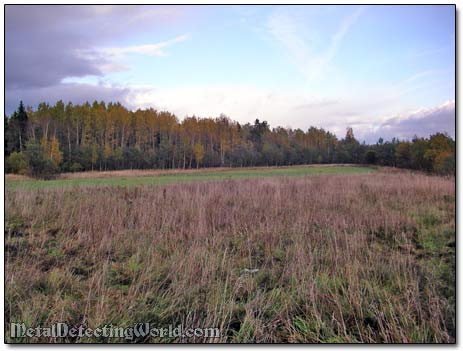
As soon as I entered the grass, I received a coin-like signal. I already knew what types of coins we would unearth here but I imagined and hoped to find the Swedish copper coins of the largest size - of 1 Öre denomination, which I admired when I saw them in a catalogue. At this moment, the copper coin I had just dug up was of a medium size.
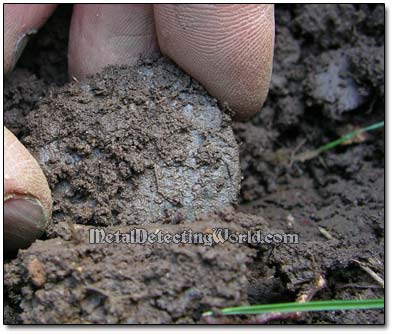
The coin was not buried deep, just at a depth equal to half of my shovel blade.
A Coin of Medium Size
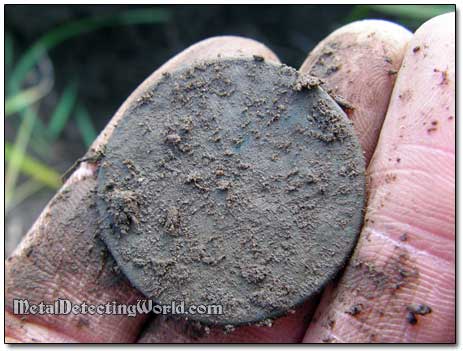
Surprisingly the copper coin was in great condition - no oxidation and having a strong relief.
1635 ¼ Öre Minted under the Rule of Queen Christina of Sweden
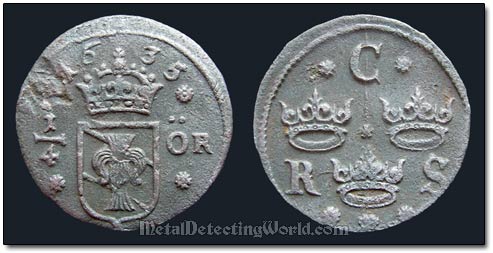
OBVERSE: 3 Crowns with letters C.R.S. (Christina Regina Sveciae - Queen Christina of Sweden)
REVERSE: Sheaf on shield below crown, divide value 1/4 ÖR and date 1635
COIN DIAMETER: 30mm
COIN WEIGHT: 10.6g
COMPOSITION: Copper (Cu)
MINTS: Nycöping and Säter
The first silver "Fyrk" coin - an equivalent to ¼ Öre, first appeared during the reign of Swedish King Gustav Vasa (1496-1560) in 1522. The first ¼ Öre copper coin, also called "Fyrk", first appeared in circulation during the reign of the Swedish king Gustavus Adolphus (1594 - 1632) in 1624. Because 1 Öre (similar to 1 Cent) had considerable purchasing power, there was a need for coins of a lesser value for small transactions. The first copper fyrk was of the Klippe type - it had a rectangular shape. The blanks (planchets) were manually cut out of the sheet copper strips, and then the coin design was applied on them with a punch and hammer.
After the Walzwerk coin-minting technology was introduced in 1625, the square fyrks were produced mechanically. In 1627, the first round copper fyrk was hammered at the Arboga mint. In 1628, when the Walzwerk Rolling Press was modified to produce round coins, the massive production of round fyrks started at the Säter mint. 258,387,369 of the 1/4 Öre coins were minted between 1633 and 1660, including 59,827,200 of the 1635 ¼ Öre copper coins minted at the Nyköping mint. The last fyrk was minted at the Avesta mint in 1660.
In 1640s, 1 liter of milk cost 2.7 fyrks, 1 pair of shoes cost 11 fyrks. 1 Daler equalled 32 Öres or 128 fyrks. A Fyrk (1/4 Öre) of 1645 corresponds to approximately $4.00 or 2.8 € in today's money.
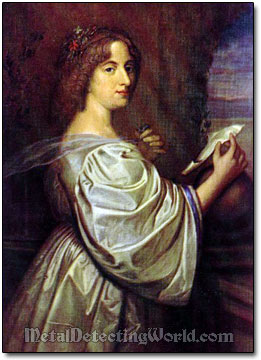
Queen Christina - Brief Historical Facts:
Christina (Swedish: Kristina Augusta) also known as Kristina Wasa, Maria Christina Alexandra, Count Dohna, Minerva of the North, Protectress of the Jews at Rome was Queen regnant of Sweden from 1632 to 1654. She was the only surviving legitimate child of King Gustavus II Adolphus of Sweden who died at the Battle of Lützen in 1632 during the Thirty Years' War (1618-1648) - the great religious struggle between the Protestants and Catholics in Europe.
Under her father's order, Christina was educated as a boy would be. Christina studied twelve hours a day daily. She learnt to speak German, French, Italian, Spanish, and Swedish and to read Latin. Christina was well-trained in the philosophy and leadership of the Stoics through readings of Tacitus, Epictetus, Seneca as well as others. She was also trained in the art of horsemanship, sword work, and all other aspects of battle and sports.
After the death of Christina's father, the power therefore passed to a regency dominated by Axel Oxenstierna who had been a chancellor and adviser to Gustavus II Adolphus - one of Sweden's greatest kings, and for the next twelve years the influence of the nobility was enhanced. Being still a minor in 1640, Queen Kristina was admitted to council meetings and begins to participate in governance of Sweden. Axel Oxenstierna ruled at the head of government until Queen Christina was of age, and continued as her advisor after she was crowned in 1644.
Christina's motto was "Wisdom is the nation's support". She was also a big coin collector. Christina's personal rule covered a decade. The first Swedish newspaper was created under Christina's leadership in 1645.
When Oxenstierna's influence declined, she effectively played competing factions against each other to achieve her desire for peace in Germany (she initiated the end of the Thirty Years War in 1648) and the recognition of her cousin, Charles X Gustav (Karl X), as her successor.
Unwilling to marry, Christina secretly converted to Catholicism. It surely was impossible for Catholic Christina to rule in Protestant Sweden, so she abdicated and left Sweden in 1654. Christina lived the rest of her life in France and Italy, where she pursued her cultural interests and flirted with politics. She died in Rome in 1689, aged 63, and was buried in St. Peter's Basilica, an unusual honor for a woman.
Both as to the number of coins struck and as to the diameter of each coin, the ¼ Öre coins were the largest issue yet in the history of Sweden: 30 million were struck only in 1635. When this particular coin was minted, the Queen was a little girl of nine. She personally had nothing to do with Treasury politics at the time as Sweden was governed by her guardian Axel Oxenstierna who was behind that abundant issue of coins.
The ¼ Öre coin was called a "fyrk" among Swedish people. "Fyrk" is a cognate of "fyra" which means "four." Back in the 1635, a barrel of beer cost 9 daler copper = 9 x 32 öre copper = 288 öre copper. A liquid barrel at that time measured 126 liters. Thus, half a liter (roughly a pint) of beer would have cost 0.35 öre copper, provided that you bought an entire barrel. If you went to a tavern, you would probably pay two or three 1/4 öre copper coins for a pint of beer.